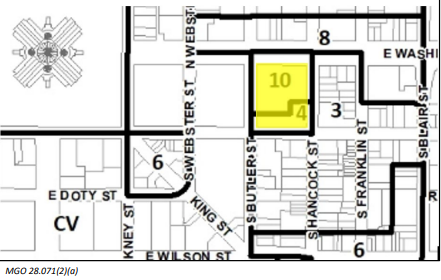
Brayton Lot Neighborhood Meeting Follow-up
postedI wanted to thank everyone that was able to attend the Brayton Lot neighborhood meeting this past Monday, 11/6. Special thanks to Ald. Rummel, Ald. Tishler, Dan Rolfs, Bill Fruhling, Pastor Peter Benson, and the St. John's Church. Your support helped us host a successful meeting.
It was great to see a strong showing of different voices throughout the greater downtown area. The meeting made it clear to me that there remains an established opinion that reflects the height map that is currently codified in the Downtown Plan of 2012. This opinion holds that a 4-story step down may maintain a pedestrian, small town feel and quality of life (ie. retained Capitol views and access to sunlight). There was another, newer, and growing voice of young people who see the height map amendment as a means to help alleviate some of their troubles in finding housing in Madison. As one person stated, they apologize for not being in attendance when the height map was established in 2012...although they were only 14 at the time over 10 years ago.
I appreciate that no one in the room argued directly against new neighbors or "those people". It's important that we ground these discussions about height and massing and neighborhood feel in the reality that we are talking about homes for our future neighbors. We want to build a Madison community that is welcoming and affordable to all people.
I can see how some feared that the height map would change their way of life and their sacrifice would not be worth it without a guarantee that it would lead to more affordable housing. There seems to be a continued clash in the downtown area between wanting to maintain things as they are versus wanting to create a city that people can afford to live in. Though people overwhelmingly can agree that affordable housing is the top priority.
On that note, as someone with experience in the affordable housing realm, I find it important to clear up some confusion from the meeting. Below I hope to answer the following questions:
- What is being proposed?
- What is affordable housing?
- How would the height map amendment impact the amount of affordable units?
- How does the height map amendment impact land costs?
- What's next?
What is being proposed?
There was quite a bit of confusion at the meeting about what is being proposed. Process matters. So, let's level-set on what is being proposed.
Myself and colleagues are proposing a height map amendment. Currently, about 2/3 of the Brayton Lot area is zoned for 10-stories/144 feet. The other third is zoned for 4 stories/60 feet. The proposed height map amendment would allow for 10 stories/144 feet on the entire lot area. Zoning the entire area for 10-stories DOES NOT mean that the approved development will be entirely 10-stories.

The height map amendment IS NOT the same thing as a request for proposals (RFP). The height map is related to zoning and the RFP is related to land use.
The RFP WILL IINCLUDE language on affordable housing. Hence, there is a guarantee that there WILL be affordable housing in the final design that council chooses. We cannot yet provide specifics on the affordability as the RFP is not completed at this time.
What is affordable housing?
A few folks at the neighborhood meeting shared that they do not understand how increasing height would increase or decrease the amount of affordable housing. It is understandable why many people can get confused, especially when we did not clearly define affordable housing. The terms "deep" v. "general" affordable housing that was used in the neighborhood meeting is not the most accurate way to describe the affordability.
In essence, we can create affordable units based on income level. The height map amendment may allow us to create more affordable units at the 60-80% AMI range. Please read more for a more detailed explanation.
Affordable housing: "housing that a household can pay for, while still having money left over for other necessities like food, transportation, and healthcare." In this sense affordable housing is dependent upon household income.
HUD defines housing as affordable when it consumed no more than 30% of a household's income. HUD defines rent burden as paying more than 30% of income on rent. Extreme rent burden is paying more than 50% of income on rent.
Since affordability is dependent on income level, affordable housing programs utilize a percentage of Area Median Income (AMI) or County Median Income (CMI) to determine the the amount and depth of affordability. Please see the table below to view percent of Dane County Median Income (CMI) by family size.

From this table, you can see Dane CMI by family size in red. Then you can see income broken down by percentage of CMI in yellow and green. So, when an alder states that they want "deep" affordability, they really mean that they would like to see housing serving people making 30-50% CMI or between about $24,000 and $62,000, depending on household size. Nonetheless, it is equally important to have units affordable to people at all income levels to maintain a healthy housing system.
Some may look at the graph and feel that income levels are higher in Dane County and that should justify focusing solely on the lower, or 30-50% AMI spectrum of income levels. This reasoning ignores that there is a mismatch in rental housing supply and demand by income level.

The 2023 Housing Snapshot Report revealed that there is a surplus of units available available at the 30-80% AMI level and a deficit of units serving income levels below 30% AMI and above 80% AMI. According to the report, "this creates a market where for the highest-income households rent is generally affordable, while being drastically unaffordable for the lowest-income households at the same time."
Based on this information, I would argue that the city should focus on developing units below 30% AMI and above 80% AMI if we want to resolve affordability issues. Since it is difficult to develop units in these income ranges, the city should focus developing units at all income levels. I believe that the units we choose to subsidize in the Brayton Lot development should reflect this broad range of income levels as it best meets the needs of the entire Madison housing system.
Putting this all together...Affordability is based on income. We can subsidize units between 30-80% AMI and it's still considered affordable. Choosing which income level to subsidize to create affordable units is far more complicated than simply choosing prioritize "deep" affordability.
How would the height map amendment impact the amount of affordable units?
The core premise behind the height map amendment is to desire to create more affordable unites. Our hope is that allowing a developer to be creative and flexible as possible may create more affordable units rather than being locked into a single design.
In essence, we may be able to development more units at the 60-80% AMI level while still maintaining the same amount of 30-50% AMI units with a more flexible design. Details explaining how the design and financing would work are fairly complicated. Feel free to reach out if you're interested.
How does the height map amendment impact land costs?
Many of neighbors favorable to the 4-story height limit sited comments by an affordable housing developer to justify their positions. The comments claimed that increasing the height map to allow up to 10-stories would increase the land value to a point that the city would be hard pressed to deny accepting the highest bidder's offer. This was interesting as throughout my conversations with other housing experts, including Justice Castaneda and Kurt Paulsen, I had not yet heard this concern.
Based on my conversations with staff and other experts, it seems that the important caveat to this reasoning is that the city owns and controls the land. Indeed, allowing up to 10-stories would increase the land value ONLY IF the city placed no additional restrictions. This scenario would not apply if the city requires a project include 30-50% AMI units, which would suppress the value of the land.
Of the guarantees I can give, I can guarantee that accepting the highest market-rate bidder is not the city's priority. Units at 30-50% AMI will most likely be included in the RFP. Hence, substantial increases in land value will be avoided and affordability will be preserved.
That said, I do intend to meet with the developer in the upcoming weeks to hear more about their perspective.
What's Next?
I encourage anyone who is interested or has opinions to reach out to me or Ald. Rummel. Also, please tune into Plan Commission (11/13, 5:30p) and Common Council (11/21, 6:30p).
Following decisions about the height map, staff will continue working on an RFP. I eagerly await learning and sharing more about the RFP.
